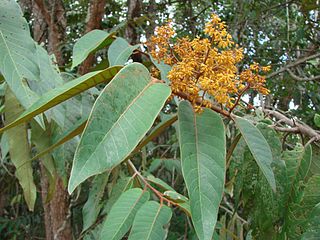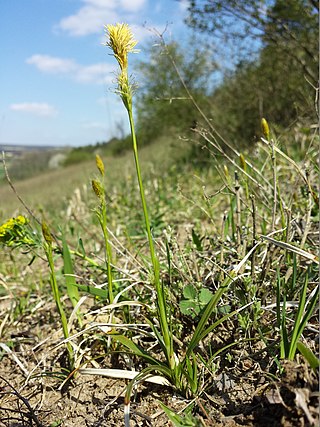
Virola is a genus of flowering plants in the nutmeg family, Myristicaceae. It includes medium-sized trees native to rainforests of the tropical Americas, ranging from southern Mexico to Bolivia and southern Brazil. Species are known commonly as epená, patricá, or cumala. They have glossy, dark green leaves and clusters of tiny yellow flowers, and may emit a pungent odor.

The Myristicaceae are a family of flowering plants native to Africa, Asia, Pacific islands, and the Americas and has been recognized by most taxonomists. It is sometimes called the "nutmeg family", after its most famous member, Myristica fragrans, the source of the spices nutmeg and mace. The best known genera are Myristica in Asia and Virola in the Neotropics.

Sphaerocarpaceae is a family of liverworts known as bottle liverworts. Approximately ten species are included in this family, most of them in the genus Sphaerocarpos, but one additional species in the genus Geothallus.

Phyteuma is a genus of flowering plants in the family Campanulaceae, native to Europe and Morocco.
Virola megacarpa is a species of plant in the family Myristicaceae. It is endemic to Panama. It is threatened by habitat loss.
Virola parvifolia is a species of plant in the family Myristicaceae. It is endemic to Brazil, Colombia and Venezuela.

Virola surinamensis, known commonly as baboonwood, ucuuba, ucuhuba and chalviande, is a species of flowering plant in the family Myristicaceae. It is found in Brazil, Costa Rica, Ecuador, French Guiana, Guyana, Panama, Peru, Suriname, and Venezuela. It has also been naturalized in the Caribbean. Its natural habitats are subtropical or tropical moist lowland forests, subtropical or tropical swamps, and heavily degraded former forest. Although the species is listed as threatened due to habitat loss by the IUCN, it is a common tree species found throughout Central and South America.

Virola sebifera is a species of tree in the family Myristicaceae, from North and South America.

Virola elongata is a species of tree in the family Myristicaceae. The tree is native to Panama, Guyana, Brazil, Bolivia, Colombia, Ecuador and Peru. It is also found in Suriname. Virola elongata is thin and 7.5–23 m (25–75 ft) tall, sometimes 30 m (98 ft) tall.
Virola calophylla is a species of tree in the family Myristicaceae. It is native to Central America and South America, namely Panama, Guyana, Suriname, Brazil, Bolivia, Colombia, Ecuador and Peru.

Virola carinata is a New World, tropical evergreen tree in the family Myristicaceae that is indigenous to Colombia, Venezuela and Brazil. It grows to a height of about 30m and its fruit is subglobular, 16–20 mm long and 17–19 mm in diameter, found in groups of 4 to 12.
Virola cuspidata is a species of plant in the family Myristicaceae. It is native to South America, occurring in Bolivia, Brazil, Colombia, Ecuador, Guyana, Peru, and Venezuela. It is a shrub or slender tree growing to 10 m (33 ft) tall.
Virola divergens is a species of tree in the family Myristicaceae. It grows to about 25m tall. The fruits are ellipsoidal and subglobular, 18–38 mm long and 16–33 mm in diameter, grouped 4 to 8.
Virola multinervia is a species of tree in the family Myristicaceae. It is found in Colombia, Peru, Ecuador, Venezuela and Brazil. It grows to a height of about 35m. The fruit is ellipsoidal to ovoidal, 26–40 mm long, 19–32 mm in diameter, and is found in groups of 1 to 7.
Virola pavonis is a species of tree in the family Myristicaceae. It is found in Brazil, Colombia, Ecuador, Peru and Venezuela. The tree grows to a height of about 15-30m tall.
Virola peruviana is a species of tree in the family Myristicaceae. It is found in Brazil, Colombia, Ecuador and Peru. It grows to a height of about 35 m (100 ft). The fruit is ellipsoidal, 14–24 mm long and 11–23 mm in diameter, forming groups of about 5 to 15.
Virola venosa is a species of tree in the family Myristicaceae. It is found in Colombia, Venezuela and Brazil. It grows 5–30 m (16–98 ft) tall.
Avellinia is a genus of Mediterranean plants in the grass family. The only known species is Avellinia festucoides, found throughout much of the Mediterranean Region from Portugal and Morocco to Turkey. It is also reportedly naturalized in Australia.

Carex michelii is a species of sedge, native to central, southern and eastern Europe, Turkey, the Caucasus, and Iran. It is typically found in semi‑arid grasslands.








